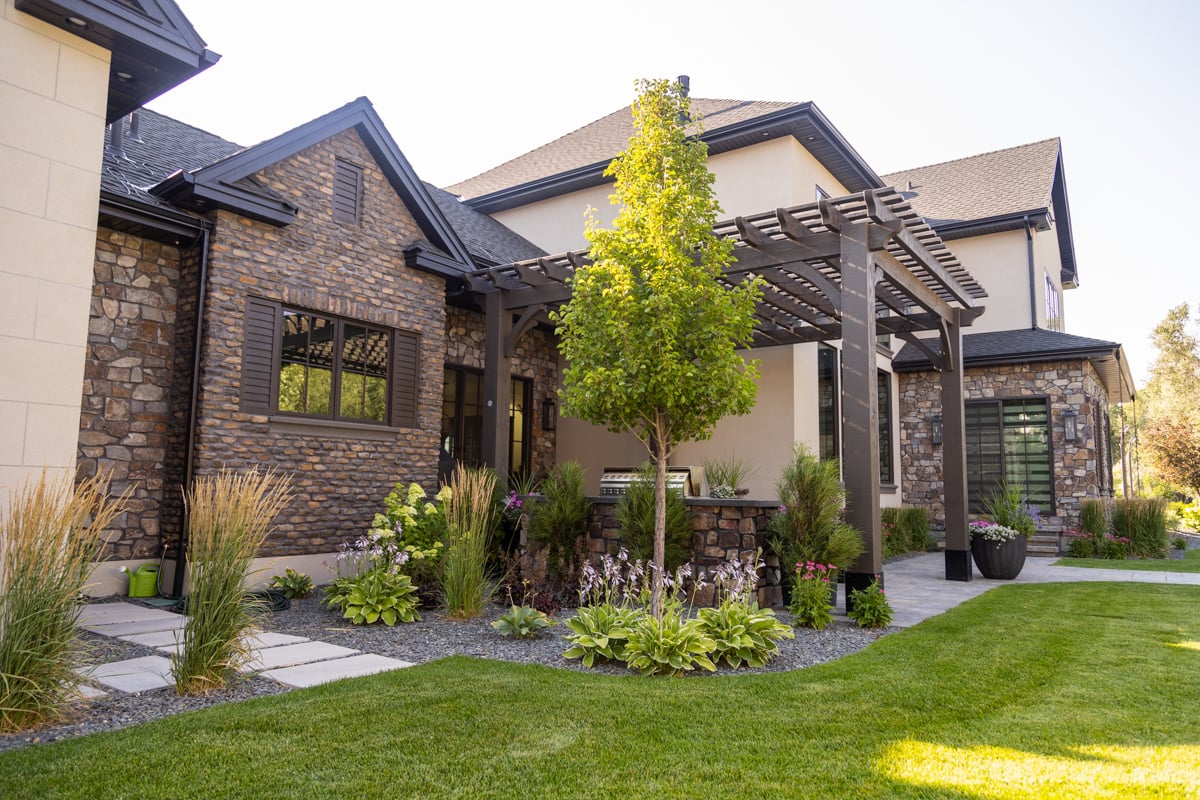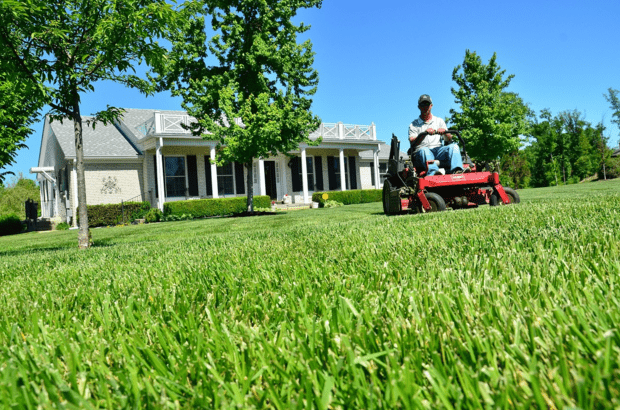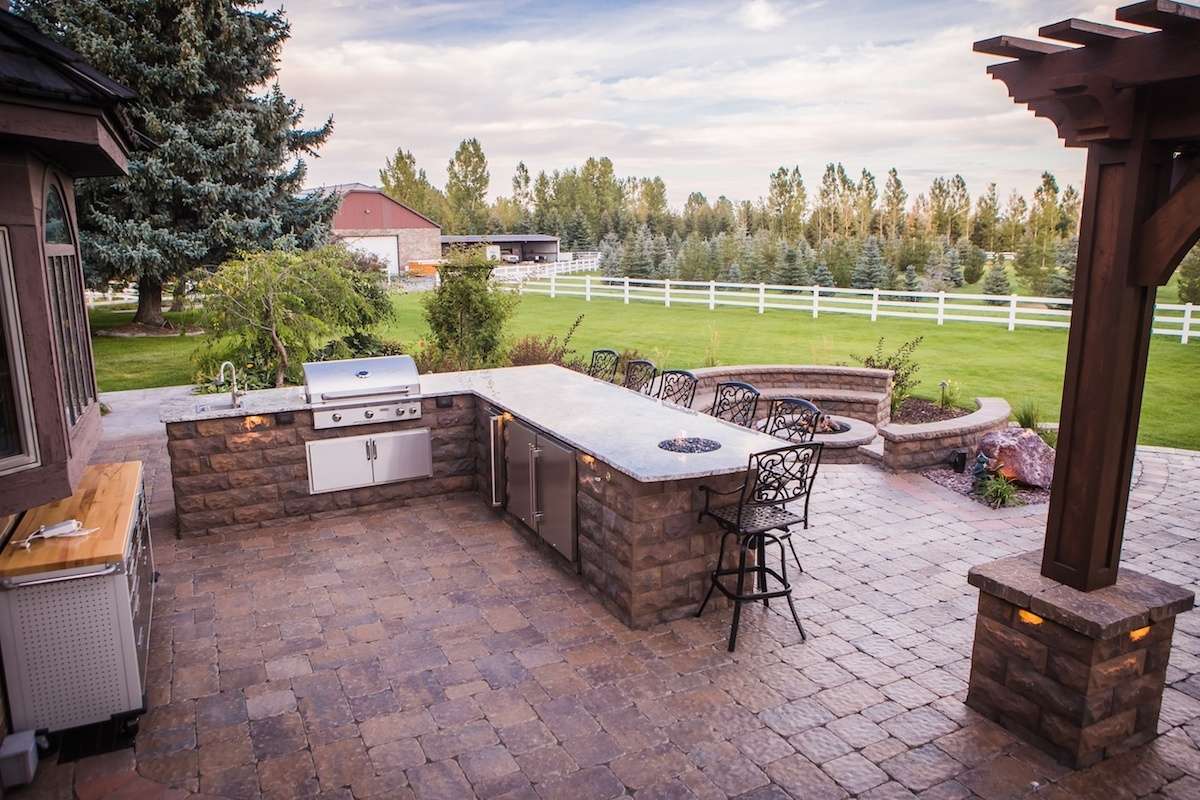

10 Summer Landscaping Tips for Idaho Homeowners
Before you hang out that “Do Not Disturb: It’s Summer” sign, take a minute to think about your landscaping.
Around the end of July, the hottest time of year here in Southeast Idaho, the daily average temperature is 87 degrees.
Not hot enough for your tomato plants to spontaneously combust, but plenty hot enough to stress your thirsty lawn, encourage ugly fungus, and lure apparently every creepy bug in the state into your house.
It’s time for your summer landscaping checklist to keeps a few pressing issues from taking over. Take a look:
1. Update Your Irrigation Controller for Summer Landscaping
If the last time you looked at your controller was last April — or 2018 — it’s time to do some adjusting.
Spring is cool and rainy, so your irrigation system doesn’t need to run as often.
It’s about to get hot and dry. Adjust your controller, please. But not to water every day. It’s tempting, we get it. If you water too often, it encourages shallow, needy roots. Water less often but deeply, and roots will grow deeper and healthier.

Early morning is the best time for lawn watering — it’s still cool, so all that precious water won’t evaporate in the hot sun.
2. Take a Stroll Through Your Irrigation
Summer landscaping puts a big demand on your irrigation system, so it’s a good idea to check your sprinkler heads and zones to make sure everything’s still working in top condition.
Plan for regular inspections so your sprinkler system won’t let you down when your landscaping is its thirstiest.
Irrigation pros inspect your whole system to make sure all the parts are working correctly, and your Idaho landscaping is getting exactly the right amount of water, with no waste.
Plus, the experts can tell you about upgrades to make your system more efficient during this peak watering season.
3. Summer Mowing 101
Warm-weather landscaping means a few specific mowing habits.
Here’s your handy guide:
Mow Tall
Yes, it would be nice to cut that lawn nice and short to buy yourself extra time for pickleball. But that’s a bad idea.
Mowing tall is high on the list of warm-weather landscaping tips. Grass should be 3 to 4 inches tall after mowing.
Cutting your grass too short stresses the grass, especially in the heat of summer, and makes it more susceptible to damage from insects and disease. And when you mow too short, the soil heats up, helping pesky weed seeds to germinate.
-772423-edited.jpg?width=1440&height=959&name=Crew-43%20(1)-772423-edited.jpg)
Never cut off more than a third of the grass blade at any one time. That goes extra for summer landscaping.
Keep Those Mower Blades Sharp
A dull mower blade shreds the grass instead of cutting it cleanly. This causes the tips of the grass to die and turn brown. The jagged edges also invite pests and disease.
A sharp blade makes a nice, clean cut, which helps the grass to heal faster. That helps keep your grass green and healthy in the heat.
Mow like a pro, and make sure your mower tires have enough air. Keep the oil changed. Stay on top of this through the summer to get the best performance from your mower.
4. Fertilizing, Times Three
Ribs on the grill. Corn on the cob. Ice cream cones. Summer makes you hungry.
Your lawn is out there saying, “Same.”
It’s easy to skip fertilizer treatments. Summer life gets busy. Make sure it’s on your summer landscaping checklist.
Your hungry Idaho lawn needs three fertilizer treatments during the growing season to stay green and healthy while you’re carving that watermelon into a swan and hosting the neighborhood cherry pit spitting contest.
Here’s the deal:
Fertilize in mid-May, around the end of June, and in early to mid-August.
Get the blend right. You want a mix of quick-release and slow-release fertilizer, delivering both immediate and long-term results to keep your lawn green and healthy.
Summer needs 25 percent quick-release and 75 percent slow-release fertilizer to keep your lawn green through the summer without big growth spikes so you’re not constantly mowing. (You have better things to do. Like pretty much anything.)
5. Summer Landscaping: Wage a War on Weeds
Sure, we all love summer, but weeds really love summer. Weeds are opportunists, poised to sneak in when they think you’re too distracted by which flip-flops to wear to notice they’re taking over.
Don’t let your guard down.

You'll want a multi-step process here, with weed control that includes pre-emergent weed treatment in the spring, to battle weeds before they sprout; broadleaf applications to hit summer dandelions and clover; and spot treatments when pesky intruders sneak in throughout the season.
6. Invest in Perimeter Pest Control
Warm weather landscaping is a big welcome mat to insect pests that love to move in with you, rent-free. Ants. Beetles. Hobo spiders. You know, all the creepy ones.
Keep them out with professional perimeter pest control, an outdoor barrier spray that helps prevent bugs from entering your home and foundation. They hate the spray, so they turn around and decide that maybe your place isn’t so welcoming after all.
Technicians typically treat about three feet up on the house and six feet out, creating a wide protective barrier around the house that includes the summer landscaping and lawn directly around your home.
Bye, bugs. It lasts about three months — perfect for rude summer infestations.
7. Warm-Weather Landscaping: Watch for Fungus
OK, fungus isn’t as exciting to watch for as, say, the ice cream truck.
But the same heat and humidity that makes popsicles taste so good makes your lawn more susceptible to fungus. So keep an eye out for it — it can strike fast.
Lawns damaged by fungus often have a brown dead spot where the grass has died, but a lighter yellowish-brown ring around it where the fungus is spreading.

Flowers and plants get hit, too, struck by powdery mildew or leaf rust.
The type of disease will determine the course of treatment.
Applying fungicides can help treat many lawn and plant diseases.
But it’s tough to tell exactly what’s killing your summer landscaping — fungus? Bugs? Drought? Unless you’re a lawn care pro.
Your best bet is to call on professionals, who can diagnose your problem and suggest an action plan.
8. Summer Landscaping Means Battling… More Bugs
Bugs are much hungrier than they look. You can’t even see their mouths. But one especially villainous trio can devour your lawn down to the roots.
Billbugs. Grubs. Sod webworms.
There’s no one treatment for all summer lawn pests, as they each have different life cycles.
Grubs and billbugs are best controlled by systemic products — insecticides that are absorbed by the grass. When lawn insects eat the grass blades or roots, they die.
Others, like sod webworms, need a contact insecticide to be applied because they’re top feeders rather than feeding on your lawn’s roots.
In any case, warm-weather landscaping in Idaho means keeping an eye out for these destructive little beasts before they destroy your lawn.
A skilled lawn care technician can diagnose your bug problem and recommend the right solution
9. Don’t Let Your Mulch Get Ratty
Maybe you thought your neighbor with the new pool was your summer best friend.
Bark mulch conserves water so you need less irrigation. It keeps your plants’ roots cool in summer’s heat.

Mulch keeps rain from washing away your soil, keeps weeds from popping up, adds nutrients to your soil, and just plain looks great. It’s a summer landscaping staple.
But not if it’s thin and ratty and leftover from last fall.
Add “fresh mulch” to your summer landscaping checklist.
Too Many Summer Landscaping Needs? Trust Outback
By now you’re probably wondering how you’re supposed to have any summer fun at all, with this long summer landscaping checklist looming.
Sounds like a job for landscaping services in Boise and Idaho Falls, ID.
Give us a call. We love checklists.
Outback Landscape is a full-service maintenance, design, and landscape installation company serving Southeast Idaho and Wyoming.
We install beautiful, functional landscapes. But our work doesn’t stop there. We’ll stay with you for the long haul, taking care of your property through all four seasons — including all the landscape challenges of summer.
Reach us by phone at (208) 656-3220 or request a consultation online. We’d love to hear from you.
If You're Looking For a Sign, This is It.
Seriously, that lawn isn't getting any better on it's own. Mrs. Jones just called the HOA on you
.jpg?width=480&name=Chase%20Coates%20Team%20Portrait%202%20(2).jpg)
Chase Coates
Chase Coates is the owner of Outback Landscape in Idaho Falls, Idaho.


Brick Pavers vs Stamped Concrete: Pros, Cons, and Costs
.jpg)

